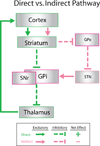DISSECTING OCD CIRCUITS: FROM ANIMAL MODELS TO TARGETED TREATMENTS
- PMID: 25952989
- PMCID: PMC4515165
- DOI: 10.1002/da.22367
DISSECTING OCD CIRCUITS: FROM ANIMAL MODELS TO TARGETED TREATMENTS
Abstract
Obsessive-compulsive disorder (OCD) is a chronic, severe mental illness with up to 2-3% prevalence worldwide. In fact, OCD has been classified as one of the world's 10 leading causes of illness-related disability according to the World Health Organization, largely because of the chronic nature of disabling symptoms.([1]) Despite the severity and high prevalence of this chronic and disabling disorder, there is still relatively limited understanding of its pathophysiology. However, this is now rapidly changing due to development of powerful technologies that can be used to dissect the neural circuits underlying pathologic behaviors. In this article, we describe recent technical advances that have allowed neuroscientists to start identifying the circuits underlying complex repetitive behaviors using animal model systems. In addition, we review current surgical and stimulation-based treatments for OCD that target circuit dysfunction. Finally, we discuss how findings from animal models may be applied in the clinical arena to help inform and refine targeted brain stimulation-based treatment approaches.
Keywords: anxiety; basal ganglia; cortico-striato-thalamo-cortical circuits; deep brain stimulation (DBS); obsessive-compulsive disorder (OCD); optogenetics; orbitofrontal cortex (OFC); prefrontal cortex; transcranial magnetic stimulation (TMS); ventral striatum.
© 2015 Wiley Periodicals, Inc.
Conflict of interest statement
No specific funding was received for this work. Dr. Dougherty reports the following potential conflicts of interest: grants and honoraria from Medtronic, Inc; grants from Cyberonics, grants from Eli Lilly, grants and personal fees from Roche, honoraria from Insys, and honoraria from J&J. Dr. Ahmari has no conflicts of interest to disclose.
Figures


References
-
- Koran LM. Quality of life in obsessive-compulsive disorder. Psychiatric Clinics of North America. 2000;23:509–517. - PubMed
-
- Kessler RC, et al. Lifetime prevalence and age-of-onset distributions of DSM-IV disorders in the National Comorbidity Survey Replication. Archives of General Psychiatry. 2005;62:593–602. - PubMed
-
- Weissman MM, et al. The cross national epidemiology of obsessive compulsive disorder. The Cross National Collaborative Group. J Clin Psychiatry. 1994;(55 Suppl):5–10. - PubMed
-
- Goodman WK, Grice DE, Lapidus KA, Coffey BJ. Obsessive-Compulsive Disorder. Psychiatr Clin North Am. 2014;37:257–267. - PubMed
Publication types
MeSH terms
Grants and funding
LinkOut - more resources
Full Text Sources
Other Literature Sources
Medical

